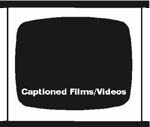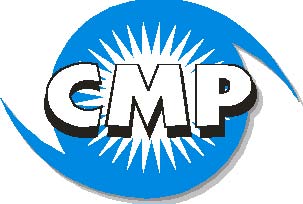<< Learning Center
Media Accessibility Information, Guidelines and Research
Captioning Timeline Highlights
Motion pictures were made inaccessible to millions of deaf and hard of hearing people in 1927, the year sound was introduced to the silent screen. Since then, several important milestones have occurred in order to make captioning available on television, films, videos, and other emerging media in the United States and beyond.

1947
Emerson Romero, a deaf man whose cousin was the famous movie actor Cesar Romero, develops the first captioning of a film by putting captions between picture frames. Romero's stage name is Tommy Albert, and he is one of five deaf actors appearing in silent films.
1949
British producer J. Arthur Rank etches open captions onto glass slides, which appear on a smaller screen in the lower left-hand corner of the main screen. When the film Dawn Departure, which contains Rank's method of captioning, has its premier showing in London, it's reported that several hundred deaf people line up to gain entrance to the theater.
Shortly after Rank's experiment, an entirely new method of captioning films was devised in Belgium, which involved etching captions directly onto a finished print of the film. Titra Film Laboratories in New York was successful in securing a franchise for the Belgian process for the whole United States.
Edmund Boatner (superintendent of the American School for the Deaf, Connecticut) and Clarence O'Connor (superintendent of the Lexington School for the Deaf, New York) organize Captioned Films for the Deaf (CFD). CFD is a private business, dependent on donations and gifts for financial support.
1951
J. Pierre Rakow, a deaf man and supervising teacher of the Vocational Department of the American School for the Deaf, learns how to caption films and then persuades people in the film industry to allow captioning of their products.
America the Beautiful is the first film to be open-captioned in America utilizing the Belgian technique. It is a 25-minute production that Warner Brothers made for $100,000 and presented to the government to sell war bonds. The Department of Treasury donates it to CFD; it is placed in circulation two years later.
CFD purchases its first films: The Noose Hangs High and Scrooge. These circulate to the New York School for the Deaf and the Lexington School for the Deaf.
1955
CFD is incorporated under the laws of the state of Connecticut. It continues to seek donations, but without much success.
1958
CFD becomes Public Law 85-905 to provide captioned Hollywood films for deaf people. John Gough, former superintendent at the Oklahoma School for the Deaf, is appointed to direct the program. To this point, CFD has developed 29 feature-length films, along with short subjects, and is circulating them among schools for the deaf.
1962
Public Law 87-715 authorizes CFD to begin acquiring and captioning educational films.
The first captioned educational film, Rockets: How They Work, opens the door to equal access to educational media for students who are deaf and hard of hearing.
1970
Malcolm (Mac) Norwood, the "father of closed captioning," becomes Chief of Media Services of the Captioned Films Branch, Bureau of Education for the Handicapped, U.S. Office of Education.
1971
The TV "captioning industry," with the Captioning Center (now Media Access Group at WGBH), is formed.
1972
Julia Child's The French Chef is the first national broadcast of an open-captioned program, airing across the United States on PBS.
To assess the possibility of "closed" captioning, a technical committee is established.
1973
The first-ever regularly scheduled open-captioned program debuts. The captioned ABC News broadcast is seen late-night on more than 190 PBS stations (and airs for nine years).
1975
PBS files a petition with the Federal Communications Commission (FCC) to reserve a segment of the television signal for transmitting captions.
1976
The FCC reserves Line 21 of the vertical blanking interval (VBI) for transmitting closed captions.
1977
Development begins on Line 21 captioning decoders.
1979
The National Captioning Institute (NCI) is formed to caption TV programs and produce decoders.
1980
Closed-captioned decoders enter the market. NCI's TeleCaption I is sold at Sears.
First closed-captioned television programs air, totaling 16 hours a week.
Captioned home videos become available; the first title is Force 10 From Navarone.

1981
First closed captioning of a children's television program, Sesame Street, is broadcast.
First open-captioned theatrical movie release, Amy, opens in ten cities.
1982
Real-time captioning of the Academy Awards and the first regular real-time closed captioning for ABC's World News Tonight is performed.
First closed captioning of a live sporting event, the Sugar Bowl, airs.
1984

CFD introduces videocassettes and becomes Captioned Films/Videos for the Deaf (CFV).
1989
Ernie Hairston becomes Chief of Media Services for CFV.
First closed-captioned music videos are produced.
1990
The Decoder Circuitry Act states that all televisions 13 inches and larger must have built-in decoder capability (takes effect in 1993).
The Americans with Disabilities Act passes.
1991
The National Association of the Deaf (NAD) receives its first U.S. Department of Education (ED) contract award to administer the selection and captioning of new CFV materials. The designation "for the Deaf" is immediately dropped from CFV promotional materials and catalogs in order to be more inclusive of the hard of hearing community. The NAD continues in this role to present time.
1993
TRIPOD Captioned Films makes open-captioned, first-run 35-mm films available to local theaters.
WGBH/The Caption Center devises the Rear Window Captioning System to show captions on movie screens using a system to display the captions in reverse at the back of the theater which are then reflected at the seat.
There are more than 750 captioned hours a week on the networks; more than 5000 captioned home videos, including a large portion of new releases; and cable channels are just beginning to introduce captioning.
1994
"Information Superhighway" speech by Vice President Al Gore becomes the first captioned event in cyberspace.
First Rear Window movie theater captioning system is installed at the Langley IMAX theater at the Smithsonian's National Air and Space Museum.
The CFV Captioning Key: Guidelines and Preferred Techniques is created and distributed. The document provides an overview regarding how to caption and includes information on the following areas: types, methods, and styles of captioning; presentation rate; text; language mechanics; sound effects; music; foreign language/dialect; and other special considerations.
CFV offers an evaluation of captioning service providers for the ED. Any company performing work for CFV is required to pass this evaluation.
1995
Live! With Derek McGinty, by Discovery Communications, becomes the first regular weekly show to be captioned on the Internet.
The NAD wins the ED contract to administer CFV distribution activity. The NAD continues in this role to present time.
1996
The Society of Motion Picture and Television Engineers (SMPTE) forms a working group for captioning standards on MPEG digital video, which is used on DVDs.
The Telecommunications Act of 1996 mandates closed captioning of video programming (takes effect in 1998).
1997
Bill Clinton's second presidential inauguration becomes the first inauguration to be simultaneously captioned live on television and the Internet.
The first Rear Window movie theater captioning system is installed in a first-run theater (at General Cinema; Sherman Oaks, California).
1998

CFV stopped circulating films and adds CD-ROMs and other multimedia to its collection, and it becomes the Captioned Media Program (CMP).
First closed-captioned video game, Activision's Zork Grand Inquisitor, is released.
1999
Five closed-captioned feature movies in ten Rear Window–equipped theaters throughout the United States are premiered.
Encarta Encyclopedia is released with captions on CD-ROM.
2001
The CMP began phasing out its services to adults due to its funding source being the Individuals with Disabilities Education Act (IDEA) and due to the proliferation of closed captioned movies on television and through video rental stores.
The CMP, through a cooperative agreement with movieflix.com, makes full-length open-captioned classic movies and television programs available on the Internet.
2002
The CMP provides the first streamed, educational open-captioned videos on the CMP website, with over 400 titles becoming available.
2006

America becomes the first country in the world to require all new television programs, with few exceptions, be closed captioned.
The CMP becomes the Described and Captioned Media Program (DCMP), offering educational media that is not just captioned for the deaf but also described for the blind.
As DCMP began, the national network of CMP depositories is eliminated. The program also drops all video (VHS) circulation, distributing educational media through streaming and DVD from the main DCMP office.
2008
The Captioning Key, a set of guidelines and preferred techniques regarding how to caption educational media, is completely revised for the web and published in October 2008.
2009
Google introduces machine-generated automatic captions on YouTube, which combines Google's automatic speech recognition technology with the YouTube caption system that's already in place. Partners for the initial launch include University of California Berkeley, Stanford, MIT, Yale, UCLA, Duke, University of California Television, Columbia, PBS, National Geographic, Demand Media, and the University of New South Wales. DCMP is also immediately added to the list. This machine translation, available worldwide, also enables people to access video content in 51 languages.
2010
The FCC implements a mandate that all Spanish-language programming first shown after January 1, 1998 must be captioned by 2010 (with some exceptions).
President Barack Obama signs the 21st Century Communications and Video Accessibility Act, which provides for the establishment of rules/requirements by the FCC for captioning on the Internet and technological devices.
2012
The following FCC mandate takes effect: 75% of all the Spanish-language video programming shown before January 1, 1998 must be captioned in the United States.
Jo Ann McCann becomes the Project Officer at the U.S. Department of Education for the DCMP grant.
2014
DCMP announces that it has developed a new interactive transcript tool. Users can search the captions (transcript) to quickly locate a specific concept, and then with one click can jump to that point in the video to view the segment. The new DCMP tool also allowed members to scroll through the transcript.
For the first time in the history of its program, DCMP begins allowing direct student access to its described and captioned media content. To support teachers and parents as they guide and mentor students in the learning process, the DCMP announces that they could now create student subaccounts.
DCMP launches a channel on Roku, a streaming "set-top box" with thousands of channels including Netflix, HBO, Showtime, ESPN, History, and DCMP! The Roku uses existing Wi-Fi and connected to a television or projector using an HDMI connection.
DCMP video content can be embedded into a member's LMS ("Learning Management System" or, CMS ("Content Management System," such as WordPress), or virtually any other HTML-based web presentation.
2015
DCMP announces the development of a native iOS app for iPhone, iPod Touch, and iPad users. Apple approves the app, and it is offered for free download to DCMP members.
Quality television programs have been made accessible for a few years through DCMP and through recipients of five Department of Education (ED) funded television access grants. DCMP now partners with these grantees and their content partners to make their accessible content available to DCMP members, distributing it through an Accessible Television Portal.
Tags:
Please take a moment to rate this Learning Center resource by answering three short questions.
